Breed Standards for Highland Cattle
The Elm Hollow Journey into the world of the Scottish Highlands began in February of 2016 the day we visited Bill and Kae Arrington at Big Ridge Highlands in North Carolina. It was there that we met what might be the most “standards correct” bull in the USA. At the time, we had no idea about STANDARDS, we only knew that the bull we were looking at was very pleasing to the eye. We were so impressed with Big Ridge Voodoo Magic that we purchased, on the spot, his offspring, Big Ridge Bearnard. “Bear” arrived in the summer of 2016 and our hope was that we would be able to produce fine looking Scottish Highlands like the ones we visited at Big Ridge.
We stumbled through our first year trying to find the beautiful balance we’d seen in the pastures of Big Ridge, but somehow almost everything fell short (until our first calves were born in the fall of 2017). We began to see the influence of a herd sire with correct “Scottish Standards” in his genetic background. . . . . Back to Bill at Big Ridge with loads of questions, the biggest one, “Will you give us your advice and input as we go forward?” Thankfully Bill was more than willing to become a mentor to our efforts.
We had so much to learn about recognizing correctness and flaws in Highlands that our heads were swimming, but we were determined to bring the best genetics we could afford to Elm Hollow. With Bear as sire, we did produce several really nice calves that will become part of our stock when they are breeding age. As we learned more, we realized that we needed more experience with hands on observation and a copy of the written standards in front of us, so off to Denver and the National Stock Show in January of 2018. (Where, by the way, an Elm Hollow heifer made her show debut!) Seeing the champions up close and personal was such a help in fixing “good standard conformation” in our heads. It was also a time to fellowship with other breeders. We were definitely the new kids on the block, but were welcomed none the less.
Fast forward to February of 2019, 3 short years after this journey began, Bill broke the news that he and Kae were ready to sell their fold and embark on a more family centered phase of life. He invited us back to select some of his beautiful cows to bring to Elm Hollow. This news brought several strong emotions to the surface. First, sadness at the thought of losing our mentor, but at the same time excitement at the prospect of bringing some practically perfect cows to Elm Hollow. During this visit, we went to visit Magic again and his new side kick Fergus. We hadn’t gone with the intention of buying a bull, much less two bulls, but when we realized that selling the fold included Magic and Fergus it seemed like a dream come true.
Bill is still mentoring us, even in his retirement from Highlands. Magic and Fergus now reside in a pasture directly in front of our house and will pass on to future generations of Elm Hollow calves the true Scottish Standards that follow. The research and examples were put together by Bill and he has generously offered them to us so we could share them on our site as we encourage those new to Highlands to learn to recognize the value of great genetics and add them to your fold at every opportunity.
Quotes from the Scottish Highland Cattle Standard (1885) are below in italics.
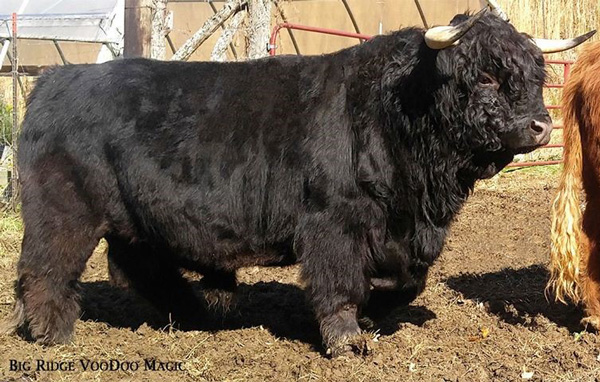
Head
“…it is most proportionate to the body of the animal, and is broad between the eyes, while short from the eyes to the point of the muzzle.” “…muzzle should, when looked at from a similar point, be short, though very broad in front, and with the nostrils fully distended…”
![]() Short wide head, eyes wide set, broad wide muzzle, with open nostrils
Short wide head, eyes wide set, broad wide muzzle, with open nostrils ![]()
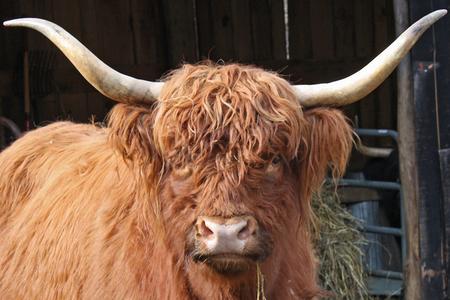
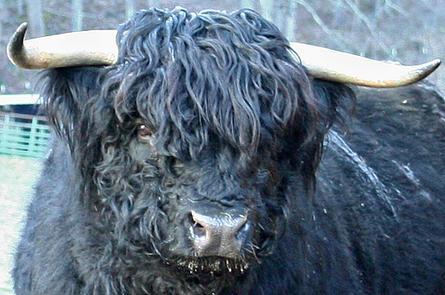
 Short muzzle, eyes midway between top of horns and end of muzzle
Short muzzle, eyes midway between top of horns and end of muzzle 

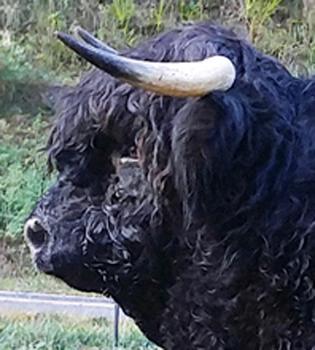
Below: Non-conforming
Long muzzles and narrow head.
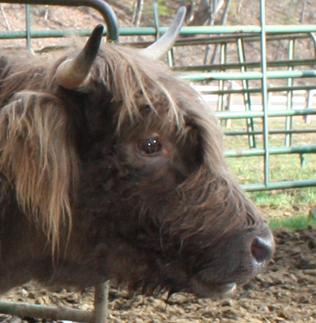

Forelock
“The forelock between the eyes should be wide, long and bushy, and any nakedness or bareness there is certain to detract from the appearance of the animal. Some would almost have the hair so wide there as to obscure the eyes, but this in many cases would be allowing one good point to over-shadow another.”
![]() bushy forelock
bushy forelock ![]()
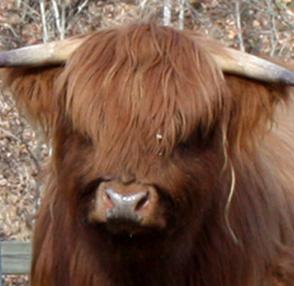
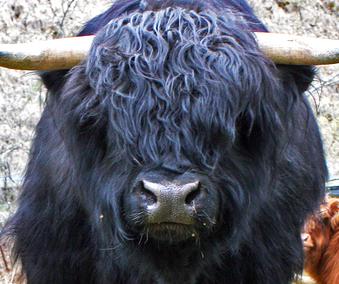
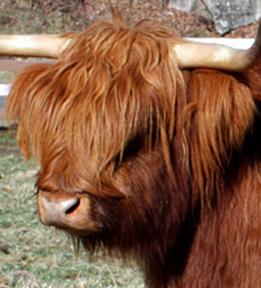
Horns
“…bulls, the horns should be strong, and come level out of the head, slightly inclining forwards, and also slightly rising towards the points. Some, however, do not care for this rise,….the masculine appearance is slightly detracted from when the horns rise directly from the crown.”
![]() horns wide set, low set (near ears), come out of head level with bull horns near horizontal and cow horns rising
horns wide set, low set (near ears), come out of head level with bull horns near horizontal and cow horns rising ![]()
Horns level out of head…
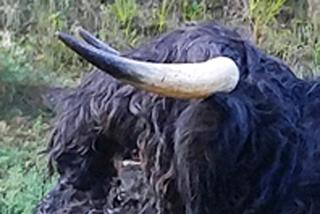
… nearly horizontal.
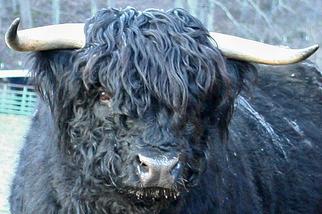
Cow horns level then rising.
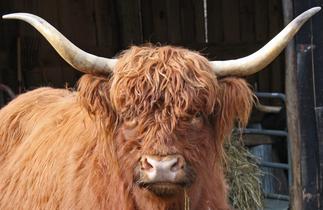
Below: Non-conforming
Horns high set, as if they are put on top of head, not coming out the side of head.
Also long muzzle, narrow head, poor forelock.


Back
“From behind the shoulder the back should be fully developed and beautifully rounded….., be as straight as possible”
This includes near LEVEL or the same distance from the rear hooves to the back, as from the front hooves to the back. This is covered in:
“The legs, both before and behind, should be short and strong.”
The back is straight if the animals back is correct structure and strong. The back is level if the legs are the same length. Short legs in front and long legs in the rear are becoming common in many animals in the U.S.
Longer legs in the rear are structurally incorrect and stress the skeleton and impair movement. At our farm the animal would have severe difficulty/danger running down hill. Does your animal or its parents have a rump that is clearly taller than it’s back or shoulders? Take a critical look at that animal and the standard, while you determine if you want to have that in your fold.
![]() back/topline level and straight, bull has hump at shoulder, then flat and level back to tail, cow flat and level from shoulder to tail
back/topline level and straight, bull has hump at shoulder, then flat and level back to tail, cow flat and level from shoulder to tail ![]()

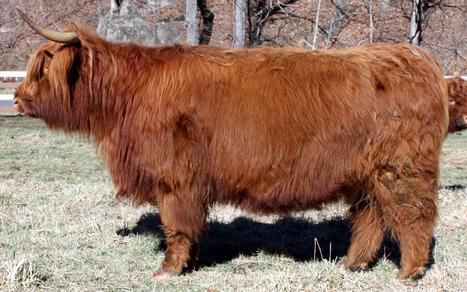
![]() proper calf toplines at 11 months old both bull and heifer
proper calf toplines at 11 months old both bull and heifer ![]()
note that some calves can grow uneven for a while
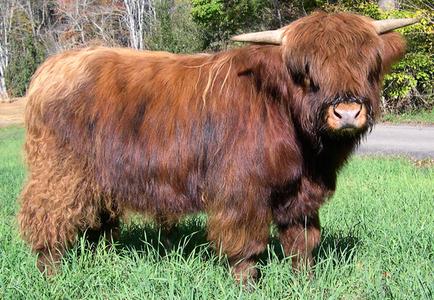
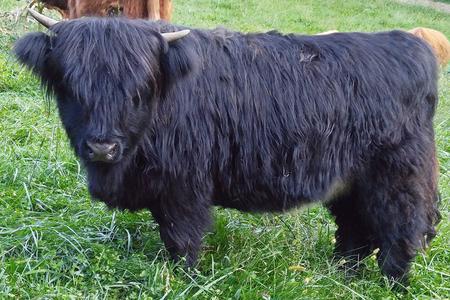
Pictures on Hills
If a Highland is on a hill or if the photographer tilted the picture to make the topline level, the highland can appear to have a level straight topline, when in fact, the back legs are 6-12 inches longer than the front legs. Topline should be about parallel to a line drawn between the cattle feet on the ground.
![]() topline straight and parrallel with the hill with same length legs
topline straight and parrallel with the hill with same length legs ![]()
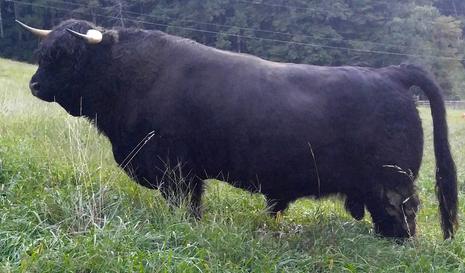
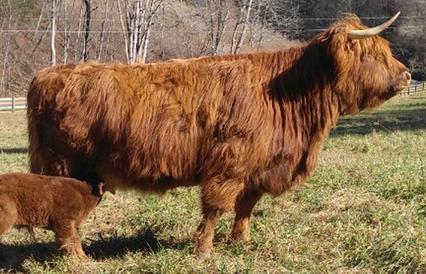
Body
“…ribs should spring boldly out and be both well rounded and deep… ” and “…the bones strong, broad, and straight…“
![]() broad and deep ribs, rounded body 2/3 of height, legs below body 1/3 height
broad and deep ribs, rounded body 2/3 of height, legs below body 1/3 height ![]()
Deep bodied 3 year old.
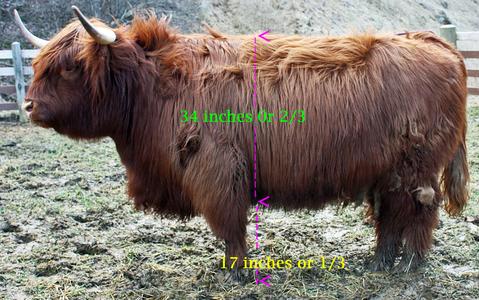
Shallow bodied 3 year old.

Deep bodied bull.
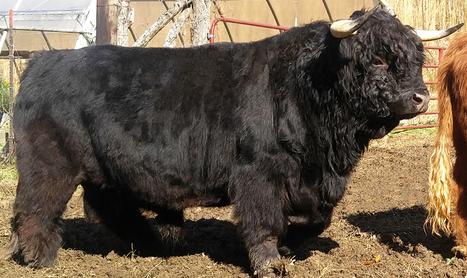
Deep bodied cow.
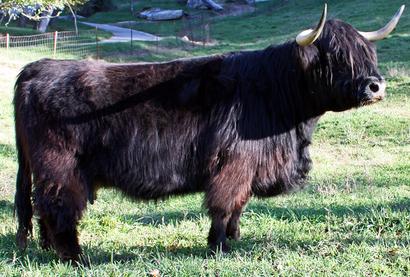
Hooves
Foot structure is genetic. How the hooves grow is also influenced by environmental factors such as diet, wetness, type of substrate cattle walk on, etc. We do not keep or breed cattle that need hooves trimmed or have bad feet for other reasons.
Good feet never trimmed or doctored on a 6 year old bull.

Bad feet below. Image search on Google “Highland Cattle feet problems for more.
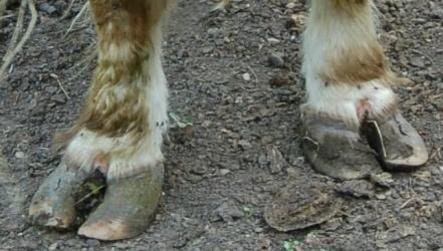
Hair
“The hair, of which there should be a great profusion, more particularly on the parts indicated, should be long and gracefully waved”
Young bull.
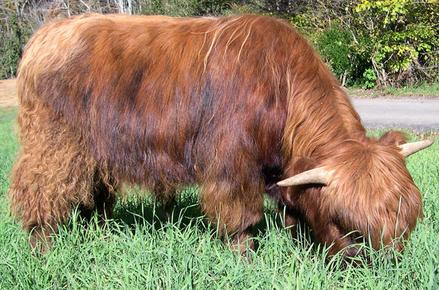
Mature bull.

Heifer.
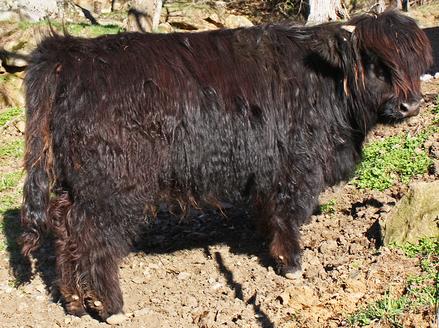
Cow.
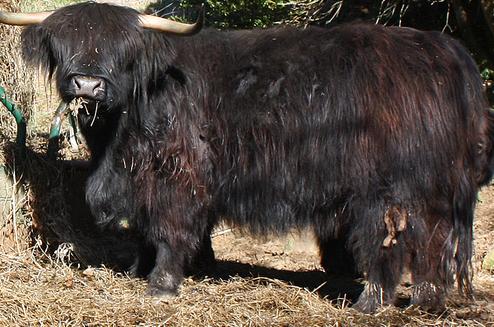
We work continually to breed animals that fit the Scottish Standard, while improving the temperament and MATERNAL traits of our animals. We believe the MATERNAL traits passed down by the bulls are the most overlooked in breeding.
We have bulls and cows producing 50-60 pound calves that are calved easily, eat unassisted soon after birth, and thrive on their mothers milk. Our bulls are bred because of the maternal traits of their parents. Some traits of Scottish Highland Cattle are not included in the Scottish Standard.
In 1885, Scottish Highland Cattle were bred by professional herdsmen that all worked to have tight udders, small teats and other traits that made the cattle hardy and better mothers while needing less care. Today it is most important to inspect Maternal traits also. Breeding animals with traits different from the Scottish standard, and especially breeding two animals that share traits different from the Scottish Standard moves the animals and breed further from the correct conformation.
The Breed Standard is our “Blue Print” for breeding at Elm Hollow Farm.
Breed Standards
This famous sketch depicting the noble head of the Highland cow, adopted by breeders and breeders’ organisations all around the globe, was first used to preface “In Retrospect”, a short account of the founding of the Highland Cattle Society of Scotland in 1884, including the description of the breed unchanged to this day.
The Society is very proud indeed to have created such a popular and enduring icon of the Highlander that binds the worldwide community of Highland cattle breeders.
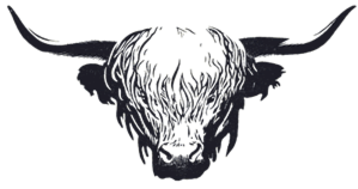
The Various Points of the Highlander may be noted as follows:
Head
Of all the representatives of our British bovine breeds, the Highlander has the grandest and most picturesque head; it is, indeed, to his head that he owes his great favour among artists. As a rule, it is most proportionate to the body of the animal, and is broad between the eyes, while short from the eyes to the point of the muzzle. The forelock between the eyes should be wide, long and bushy, and any nakedness or bareness there is certain to detract from the appearance of the animal. Some would almost have the hair so wide there as to obscure the eyes, but this in many cases would be allowing one good point to over-shadow another.
The eyes should be bright and full, and denoting, when excited, high courage. When viewed sideways, there should be a proportionate breadth of the jawbones readily observable, when compared with the width of the head in front, whilst the muzzle should, when looked at from a similar point, be short, though very broad in front, and with the nostrils fully distended, and indicating breeding in every way. One of the most noteworthy features in a Highlander, is of course, the horns. In the bulls, the horns should be strong, and come level out of the head, slightly inclining forwards, and also slightly rising towards the points.
Some, however, do not care for this rise, though any drooping is considered to be a very bad fault when between the crown and the commencement of the curve, as this is generally accompanied by a low weak back. Some, too, are of opinion that the masculine appearance is slightly detracted from when the horns rise directly from the crown. This, however, can only readily be detected and commented upon when particular animals are brought before experienced judges, as within a show ring.
As regards the horns of the cow, there prevail two opinions. As a rule, they come squarer out from the head than in the male, rise sooner, and are somewhat longer, though they preserve their substance and a rich reddish appearance to the very tips. The lack of the appearance of substance or “sappiness” about the horns of the male would be very much against the animal in the show-yard. The other taste is that for a female, the horns of which come more level from the head, with a peculiar back set curve, and very wide sweep. A large number of enthusiastic breeders seem to prefer, by comparison, the latter, which gives possibly the more graceful appearance. In all cases, however, the horns of a Highlander, when well set, gives the animal a stamp of nobility which causes it to attract the attention of any stranger who might pass heedlessly by animals of other breeds as merely cows, bulls or oxen.
The Neck and Shoulders
The neck should be altogether clear and without dewlap below. It should form a straight line from the head to the shoulder in the cow, but in the bulls should have that distinct crest common to all animals of the bovine species. This crest should come gracefully down to the roots of the horns, and, being well coated with wavy hair, the masculine appearance of the animal is fully completed. The shoulder should be thick and should fill out greatly as it descends from the point to the lower extremity of the forearm.
Back , Body and Hind-Quarters
From behind the shoulder the back should be fully developed and beautifully rounded. Any slight sinking or hollow is most decidedly objectionable. It should also, as in the Ayrshire, be as straight as possible, and the ribs should spring boldly out and be both well rounded and deep. When measured across the hips the breadth should be very great, and the quarters should be exceedingly well developed from the hips backwards. The thighs should also be well developed, and should show great fullness. Viewed generally, the quarters should be square between the hips and the tail, and from between the tail right down to between the hind feet. The legs, both before and behind, should be short and strong, the bones strong, broad, and straight, the hoofs well set in and large, and the legs well feathered with hair. The animal should be set wide between the fore-legs, and it should move with great dignity and style, as this is considered to be one of the most reliable evidences of careful and true breeding.
Hair
The hair, of which there should be a great profusion, more particularly on the parts indicated, should be long and gracefully waved, very much as in what dog-breeders denote wavy-coated retrievers. To have a curl is to possess a decided fault, and one which has of late years become unfortunately too common in some folds. This has been attributed in some quarters to a growing desire to make Highlanders grow big from feeding them higher and housing them more. At any rate, experience goes far to prove that the more exposed they are the greater the profusion of the hair, and the less its tendency to curl. Thus, the reason of the island cattle being always so much better haired than the mainland cattle is owing to their never being housed in winter.
The usual colours are black, brindled, red, yellow, and dun, and there is considerable difference of opinion among breeders as to which is preferable.
In general, as to colour, it may be said that a good herd should possess a mixture – avoiding always all those which indicate unhealthy thrivers. The thickness of the skin, as in all fattening breeds, comes in for a considerable amount of attention, but it has to be borne in mind always that the Highlander has been adapted by nature to withstand great exposure.
Inverness, 10th June, 1885.
Head
Short wide head, eyes wide set, broad wide muzzle, with open nostrils
Head
Short wide head, eyes wide set, broad wide muzzle, with open nostrils
